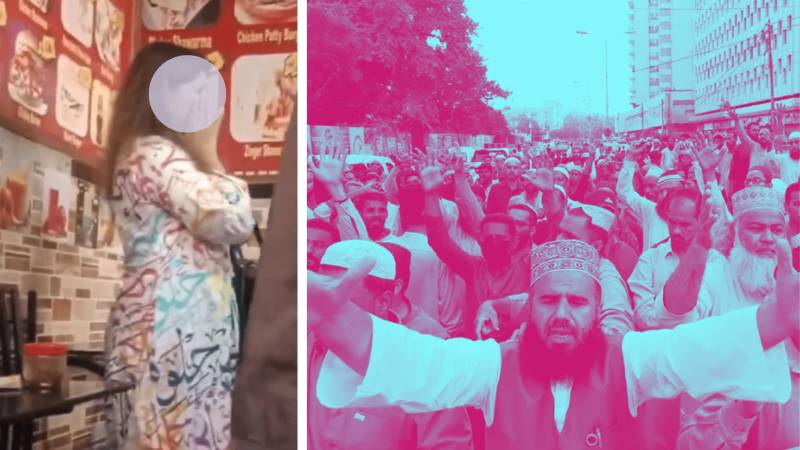
On February 25, 2024, another outrage happened on the streets of the Punjab province of Pakistan. A woman wearing some Urdu/Arabic calligraphy on her dress was attacked by a mob of Tehrik-e-Labbaik, Pakistan (TLP) in the working to lower middle class, Ichra, neighborhood of Lahore. The mob took exception to her dress with Arabic calligraphy, calling it blasphemous as the text might be Quranic. Of course, the text was no such thing. All I could make out was ‘halwa’ (pudding), on her dress. The social media and the press is atwitter with outrage. Some lament the end of Pakistan at the hand of extremism, others blame Zia, and yet others blame the placation of the likes of TLP by the Pakistani state. None of the voices are necessarily wrong. Except that I think that something more visceral, and equally insidious, besides radicalisation, might be afoot here.
Women, being attacked, molested, raped and killed for the simple act of being in a public place is sadly all too routine an occurrence in the streets of South Asia. Our neighbour to the East (India) being something of a champion this perversity. The comparison is not to belittle the gravity of the crime we witnessed in Ichra, but rather to think through the strands that may link such normalisation of violence, mostly against women and other times against men too, in Pakistani society.
For four years my team of researchers along with colleagues at the Institute of Business Administration (IBA) Karachi, undertook a project investigating the drivers of gender-based violence in 12 lower middle and working class neighbourhoods of Karachi and Rawalpindi/Islamabad. A wealth of insights emerged from it on why gender-based violence happens. The findings are too complex and varied to cover in this short intervention, but a key insight was failure of masculinity driving violence against women.
Insecure/toxic masculinity is not just the preserve of the powerless. The hyper-masculine arenas of elite sports and the military are equally fertile breeding grounds for the same
In a fast urbanising society like Pakistan, the old social norms and taboos are increasingly under strain. Young men freed from the traditional disciplines imposed by kinship and community ties in anonymous cities, are increasingly trying to live up to different standards of masculinity and success than their rural ancestors had to. In Pakistani working-class urban areas, the traditional patriarchal values underwrite young people’s masculinity — a woman is for the home, she’s to be chaste—and men are to be the providers of their families. Except that unemployed men cannot be providers. Single-income households cannot survive in a monetised urban economy. So, women have to work, even if their men pretend that they don’t have to, and must not.
Cultural change in Pakistan also means that young people are not married in their mid to late teens as was the case in the past. Instead, women, and men are marrying later and later, for men in urban areas, generally in late 20s and for women in their early to mid-20s. Young men and women of reproductive age, about town, in a sexually repressed society means that women’s bodies are objects of intense desire. But equally segregated education and patriarchal upbringing means that boys and young men do not have the social skills to approach women as human beings in an amorous register. The complete and utter social evisceration in the face of the objects of their desire, inevitably leads to intense violent impulses, which are consummated under one pretext or another.
The above is not psychologising but rather drawing upon a vast body of academic literature that links intense violence to equally intense desire for the victim of violence. In case of urban Pakistan then, religion is the latest in a long list of justifications for failed masculinities to salvage some satisfaction through violence. From family honour, to blasphemy, the eviscerated, socio-economically impotent masculinity of Pakistani men finds refuge in violence. The seemingly well to do woman, with apparently good taste, had to have been intensely desired by the working class men about the streets of Ichra. What to do? Can’t think of anything, but Oh yes! Blasphemy! Desecration of the Quran! I can’t possess her, but I can molest her before I kill her with impunity.
To millions of the most powerless, the Pakistani state has unwittingly handed the weapon of religion to get some power. They get smoke blown in their faces by fancy cars passing by. They see sickening consumerism around them. They get humiliated by the begums of Lahore and Karachi everyday and can’t do a thing about it. And then viola! The fig leaf of religion gives them the pass to finally extract revenge. And what could be easier and more delicious than the female body upon which to inscribe class resentment?
Insecure/toxic masculinity is not just the preserve of the powerless. The hyper-masculine arenas of elite sports and military are equally fertile breeding grounds of the same. I should know, I idealised them all in my youth, and the patriarchal values that came with it.
The point of the above is not to excuse violence against women or inscription of unrequited male desire, and hence violence on women’s bodies. The point is to provoke a conversation around Pakistani masculinities, their toxicity and their corrosive impact upon not just women’s lives, but worse on men’s mental and physical well being. Women, men and genders in between are not going find separate peace. The Pakistani state may have spent decades trying to promote violent, nationalist masculinity. But that project has imprisoned men in toxic masculinity and landed us where we are. The Pakistani state is too brain dead to see it. It is up to the society to have new conversations on, and tell different stories about, the foundational attribute of humanity—gender.

